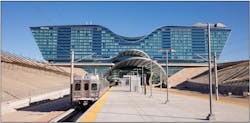‘Train to the Plane’ Line Opens in Denver
On April 22, the Denver Regional Transportation District (RTD) opened the University of Colorado A Line, a 22.8-mile electrified commuter rail corridor. Residents and visitors now enjoy an easy, affordable and reliable link between Denver International Airport and the Mile High City’s thriving downtown area, via Denver Union Station.
Part of the voter-approved FasTracks plan to expand transit across the metro region, the University of Colorado A Line is the flagship line in the Eagle P3 project, RTD’s planned commuter rail network, and the nation’s first full public-private partnership transit project of this size. The University of Colorado A Line connects communities not currently served by existing rail.
“RTD’s visionary leadership has created a truly unique and remarkable new transit option for the Denver region,” HDR Transit Director Tom Waldron said. “Many aspects of this project have already inspired other transportation agencies, both in the U.S and abroad.”
Fluor/HDR Global Design Consultants, LLC, (Fluor/HDR) is the lead engineering firm for rail-system engineering, design and implementation for Eagle P3’s three commuter lines totaling 36 miles, including the University of Colorado A Line and its nearly 23 miles of trackway. The team also designed and provided construction support for all aspects of the rail line’s associated infrastructure: 16 rail bridges, 13 grade crossings, six transit stations (plus one underway), and one traction-power substation.
At a total cost of $2.2 billion, the Eagle P3 project draws financing from both public- and private-sector sources, including RTD sales taxes, a $1.03 billion federal grant and $450 million in private dollars from the project’s concessionaire, Denver Transit Partners (DTP). Denver Transit Partners is the designer and builder, as well as the operator and maintainer of RTD’s commuter rail network until 2050.
RTD selected Denver Transit Partners based on its best-value proposal. With Fluor/HDR as its lead designer, DTP proposed many alternative technical concepts that improved the project’s cost effectiveness and satisfied RTD guidelines. Among them was the use of alternating-current electricity to power the University of Colorado A Line trains, one of the first electric commuter lines in the Western U.S. to employ AC power rather than a more common, direct-current system.
“The trains are powered by alternating current through the overhead catenary system, which was an efficient and cost effective solution because of our ability to construct a reduced number of larger power substations,” HDR Principal Project Manager John Kalvelage said. “Typical rail transit systems that use direct current require a traction-power substation every 1.5 miles. Consequently, the University of Colorado A Line cost less to build, and will cost less to operate and maintain.”
The University of Colorado A Line trains transport passengers at speeds up to 79 mph. Travel time between Denver Union Station and Denver International Airport is about 37 minutes. The trains stop at each of seven stations in 15-minute intervals during peak hours and 30-minute intervals during off-peak hours. The University of Colorado A Line links with the city’s existing light-rail service via Denver Union Station, offering visitors many transit options for navigating the city and an alternative to congested highways. By 2030, daily ridership is expected to reach nearly 38,000.
Opening of the University of Colorado A Line was celebrated with a ceremony at Denver International Airport on April 22, where Colorado Gov. John Hickenlooper and other special guests commemorated the achievement. Communities adjacent to the University of Colorado A Line hosted additional celebrations April 23 at each of six transit stations. Denver RTD also offered free fares to ride the new University of Colorado A Line during the Friday and Saturday celebrations prior to starting regular revenue service on Sunday.
